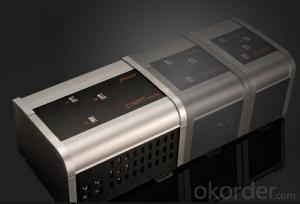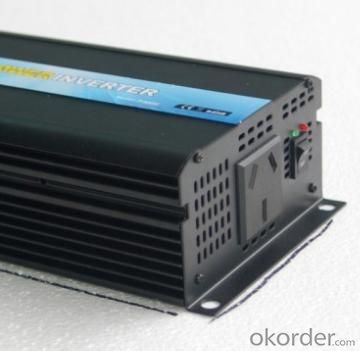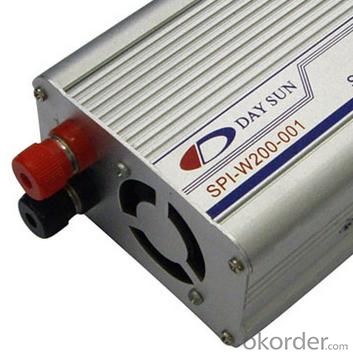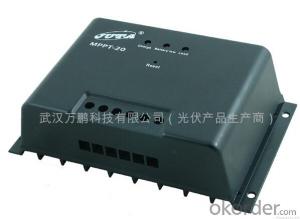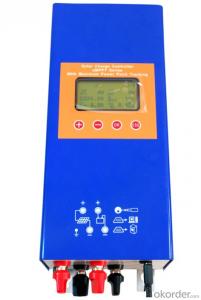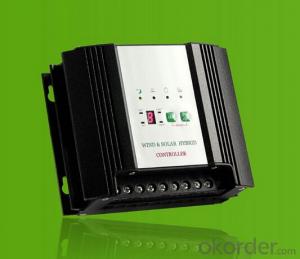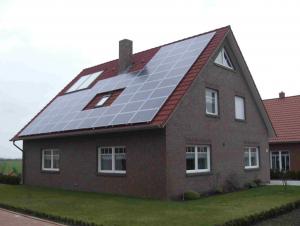Passive and Active Solar Energy Systems Solar MPPT 100/30 (30 A) Maximum Power Point Tracker
- Loading Port:
- China Main Port
- Payment Terms:
- TT or LC
- Min Order Qty:
- -
- Supply Capability:
- 10000 unit/month
OKorder Service Pledge
OKorder Financial Service
You Might Also Like
1, Product desciption
Inverter circuits designed to produce a variable output voltage range are often used within motor speed controllers.
The DC power for the inverter section can be derived from a normal AC wall outlet or some other source. Control and feedback circuitry is used to adjust the final output of the inverter section which will ultimately determine the speed of the motor operating under its mechanical load.
Motor speed control needs are numerous and include things like: industrial motor driven equipment, electric vehicles, rail transport systems, and power tools. (See related: variable-frequency drive ) Switching states are developed for positive, negative and zero voltages as per the patterns given in the switching Table.
The generated gate pulses are given to each switch in accordance with the developed pattern and thus the output is obtained.
2, Features of the product
Inverters convert low frequency main AC power to higher frequency for use in induction heating.
To do this, AC power is first rectified to provide DC power. The inverter then changes the DC power to high frequency AC power. Due to the reduction in the number of DC Sources employed, the structure becomes more reliable and the output voltage has higher resolution due to an increase in the number of steps so that the reference sinusoidal voltage can be better achieved.
· Built-in 1 year data logger for system analysis
· Charge and discharge status display
· Acoustic load disconnect pre-warning
· Load status indication
· Choose between 5 load disconnect algorithms
· Boost/absorption/float PWM-regulation (series type)
· Integrated temperature compensation
· Covered terminals (up to 16 mm2 wire size)
· Full solid-state protection
The first thing to figure out is the length of road in need of street lights.
This can be a small entrance road only a couple hundred of feet long to miles of streets through an area. Does the area currently have any type of lighting available.
What is the reason for needing street lights in this area
Is the electrical grid already nearby or would you need to call in the power company to bring in electrical lines.
If the electric needs to be brought to the area, how much is this going to cost? Depending on how far the grid electric is from the location of the needed lighting, this can be quite expensive.
How much lighting is needed on the street? Do the lights need to be dark sky compliant.
Do the street lights need to run from dusk to dawn or for only a specified number of hours at night.
Are the street lights able to dim in the middle of the night and still provide enough lighting.
These questions need to be answered before you can decide on how many lights you will need to complete the project.
3, Product Image
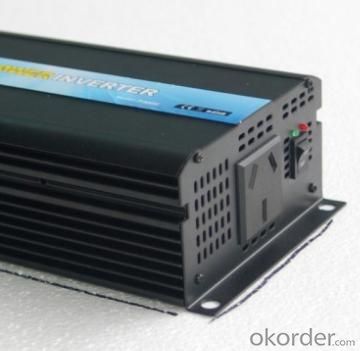
4, Detailed Specification
INPUT | |
Input voltage range | 185~265±5Vac |
OUTPUT | |
Output voltage range | 185~265±5Vac (AC mode) , 230Vac (DC mode) |
Output frequency (DC mode) | 50Hz (48~54Hz) or 60Hz(58~64Hz), same as AC(AC mode) 50Hz ±0.3Hz (DC mode) |
Wave form | Sine wave (DC Mode) |
Transfer time | 10ms. (Typical) |
BATTERY | |
Rated charging current (max.) | 45A |
Norminal DC input voltage | 12V |
Min. DC start voltage | 20V / 40V |
PHYSICAL | |
Unit dimension (mm) | 526*277*212 |
Master box dimension (mm) | 620*350*370 |
Net weight (1pc, kg) | 22.8 |
- Q: How do solar energy systems impact utility bills?
- Solar energy systems can significantly reduce utility bills by generating electricity from the sun, thereby decreasing reliance on traditional energy sources. This cost-saving impact is achieved through the production of renewable energy, which reduces or eliminates the need to purchase electricity from the grid.
- Q: Can a solar energy system be installed on a farm?
- Yes, a solar energy system can be installed on a farm. In fact, farms are an ideal location for solar energy installations due to their vast open spaces and availability of sunlight. Solar panels can be mounted on rooftops of farm buildings or installed on the ground using mounting structures. The energy generated by the solar panels can be used to power various farm operations such as irrigation systems, lighting, heating, and cooling systems. Additionally, a solar energy system can help farmers reduce their reliance on traditional energy sources, lower their energy costs, and contribute to a more sustainable and environmentally friendly agricultural practice.
- Q: Can solar energy systems be used in areas with extreme temperatures?
- Yes, solar energy systems can be used in areas with extreme temperatures. However, the performance and efficiency of these systems may be affected by extreme heat or cold. Proper design and maintenance are essential to ensure optimal performance in such conditions.
- Q: Are there any risks of electrical shocks during installation or maintenance of solar energy systems?
- Yes, there are risks of electrical shocks during the installation or maintenance of solar energy systems. Solar energy systems involve working with electrical components, including solar panels, inverters, and batteries, which can carry high voltage. If proper safety measures are not followed, it is possible to come into contact with live electrical parts and receive an electrical shock. Some common risks that can lead to electrical shocks include improper installation, inadequate training or knowledge of electrical systems, failure to use personal protective equipment (PPE), and lack of proper grounding. When installing or maintaining solar energy systems, it is crucial to follow safety guidelines and regulations, such as wearing insulated gloves, using insulated tools, and ensuring that the system is properly grounded. Additionally, working at heights during installation or maintenance poses an additional risk of electrical shocks. It is important to exercise caution to prevent falls or accidental contact with live electrical parts while working on rooftops or elevated areas. To mitigate the risks of electrical shocks, it is recommended to hire qualified and trained professionals for the installation and maintenance of solar energy systems. Regular inspections and maintenance checks should also be conducted to identify and address any potential electrical hazards. Overall, while solar energy systems offer numerous benefits, it is essential to be aware of the potential risks of electrical shocks and take necessary precautions to ensure the safety of individuals involved in the installation or maintenance process.
- Q: Can a solar energy system be used to power electric vehicles?
- Yes, a solar energy system can be used to power electric vehicles. Solar panels can generate electricity that can be stored in batteries and used to charge the batteries of electric vehicles. This can provide a sustainable and renewable source of energy for powering electric vehicles.
- Q: Do solar energy systems require regular maintenance?
- Yes, solar energy systems do require regular maintenance. This includes cleaning the solar panels, checking for any damage or debris, and inspecting the overall system performance. Regular maintenance ensures optimal efficiency and longevity of the solar energy system.
- Q: Can a solar energy system be used in areas with high levels of dust or sand?
- Indeed, areas abundant with dust or sand can indeed utilize a solar energy system. Nonetheless, it is imperative to acknowledge that an excess build-up of dust or sand can gradually diminish the system's efficiency. To address this issue, it may be necessary to perform regular maintenance and cleaning of the solar panels. Moreover, the installation of the panels at an inclined angle or the application of anti-reflective coatings can assist in minimizing the detrimental effects of dust or sand on the system's performance. Despite these hurdles, solar energy systems can still thrive in such locations, particularly when appropriate precautions and maintenance measures are implemented.
- Q: Can a solar energy system be used in areas with high levels of air pollution?
- Yes, a solar energy system can still be used in areas with high levels of air pollution. While air pollution may affect the efficiency of the solar panels to some extent, they can still generate electricity. However, it is important to regularly clean and maintain the panels to ensure optimal performance. Additionally, investing in advanced air filtration systems can help mitigate the impact of air pollution on the solar energy system.
- Q: Can solar energy systems generate enough electricity to power a home?
- Yes, solar energy systems can generate enough electricity to power a home. The amount of electricity produced by a solar energy system depends on various factors such as the size and efficiency of the system, the geographical location, weather conditions, and the energy consumption patterns of the household. In general, a well-designed and properly installed solar energy system can generate enough electricity to power a typical home. The system consists of solar panels that capture sunlight and convert it into electricity through the photovoltaic effect. This electricity can be used to meet the energy needs of a home, including powering appliances, lights, heating and cooling systems, and other electrical devices. To ensure sufficient electricity production, it is important to consider the energy requirements of the home and design a solar system accordingly. This includes determining the appropriate number and size of solar panels, as well as incorporating energy storage solutions such as batteries to store excess electricity for use during cloudy days or at night. Moreover, advancements in solar technology, such as high-efficiency solar panels and smart inverters, have significantly improved the energy output of solar systems. Additionally, net metering programs in many areas allow homeowners to sell excess electricity back to the grid, further enhancing the economic viability of solar energy systems. While solar energy systems can generate enough electricity to power a home, it is crucial to assess the specific circumstances of each home to determine the feasibility and efficiency of installing such a system. Consulting with a reputable solar energy provider and conducting a thorough assessment will help homeowners make informed decisions about harnessing solar power for their homes.
- Q: Can a solar energy system be installed on a commercial parking lot?
- Installing a solar energy system on a commercial parking lot is indeed possible. In fact, these parking lots offer an excellent opportunity for solar panel installation due to their spacious and sunlit nature. Solar panels can be placed on the canopies or elevated structures of the parking lot, such as carports, which not only provide shade for parked vehicles but also generate clean and renewable energy. This has multiple benefits, including reducing the commercial establishment's carbon footprint, creating shaded parking spaces, and potentially earning revenue by selling excess energy back to the grid. Moreover, installing a solar energy system on a commercial parking lot helps to promote sustainability and environmental awareness among customers and employees, making it a mutually beneficial solution for businesses and the environment.
Send your message to us
Passive and Active Solar Energy Systems Solar MPPT 100/30 (30 A) Maximum Power Point Tracker
- Loading Port:
- China Main Port
- Payment Terms:
- TT or LC
- Min Order Qty:
- -
- Supply Capability:
- 10000 unit/month
OKorder Service Pledge
OKorder Financial Service
Similar products
Hot products
Hot Searches
Related keywords
